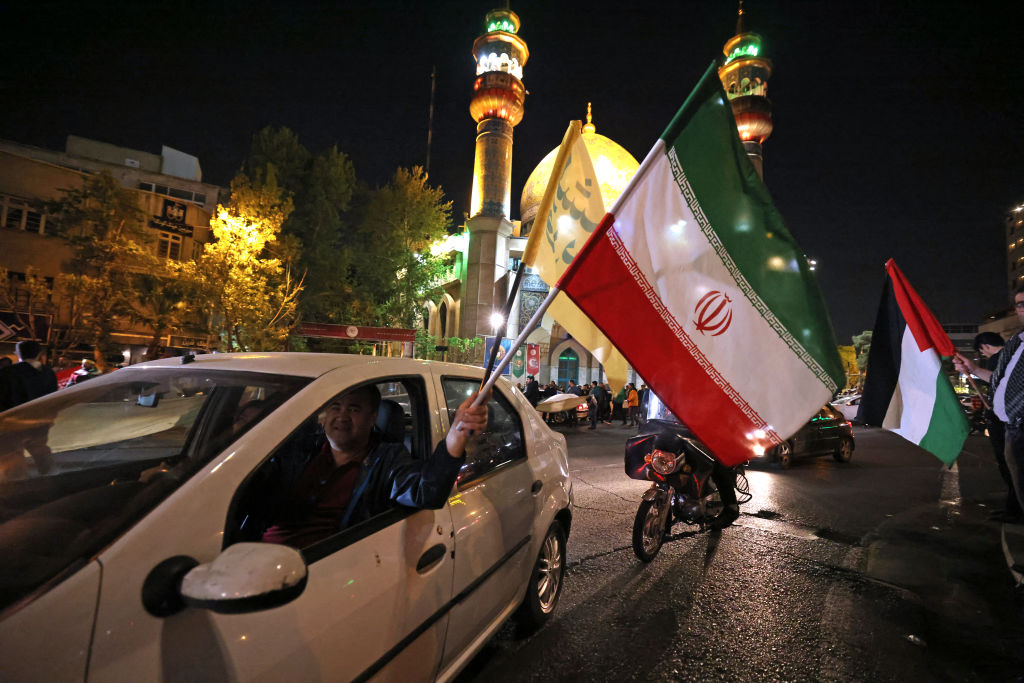Iran’s overnight mass drone attack on Israel was supposed to be payback for the assassination of Iranian Republican Guard Corps commander General Mohammad Reza Zahedi. In truth, though, it was a tepid, face-saving response which the ayatollahs in Tehran knew would fail.
In the early hours of this morning, the Iranian army described what it called “Operation Honest Promise” — the drone and missile attack on Israel — as a complete success. But in reality, the attack had minimal tactical impact, despite the highly orchestrated flag waving jubilation in Tehran’s Palestine Square.
Iran’s military would have made certain that both Israel and the US, knew what was coming
Former MI6 chief Sir Alex Younger said recently that covert intelligence gathering, the trade craft of his former career, “was not about starting wars, but preventing them.” Iran’s military would have made certain that both Israel and more importantly, the US, knew what was coming. After all, the last thing Iran wants at the moment, given its current domestic troubles of soaring inflation and the public’s growing dissatisfaction with its autocratic theocracy, is a costly and unwinnable war with Israel.
Israel probably has the world’s most effective air defense system in the Iron Dome and the newer laser-based Iron Beam. They can easily shoot down the slow, lumbering one-way drones fired by Iran. Both systems use radar to detect incoming missiles or drones. The Iron Dome uses missiles to destroy the threat while Iron Beam uses a high energy laser; it would appear that both have been very effective. The attack was, however, probably further complicated by Iran’s use of ballistic and cruise missiles which can fly much faster and carry a heavier explosive payload. But early indications suggest that these too failed to hit any targets of significance.
The drones Iran used were Shahed-136s: similar to those they have supplied in large numbers to Russia for attacks on Ukraine over the past eighteen months, as well as to Houthi rebels in Yemen. These travel at around 110-120mph, meaning the drones took several hours to reach their targets and so have no element of surprise. More than 300 drones and missiles were fired in several waves, possibly with the aim of attempting to overwhelm Israeli air defenses — but that tactic appears to have failed given that 90 percent of the drones were shot down or intercepted. Cruise missiles like the Iranian Soumar family, on the other hand, travel at 500-550mph and carry much larger explosive warheads, whilst ballistic missiles travel at thousands of miles per hour with larger warheads still. But early indications suggest that few if any got through. Iran’s attack also attracted a coordinated defense of Israel by several nations, including the US, the UK, France and Jordan — which is significant given the controversy surrounding Israel’s war in Gaza.
Despite the apparent failure of Iran’s retaliatory strike, Iran’s military capability should not be under-estimated. In spite of years of sanctions and hence out of necessity, Iran now has one of the largest defence industries in the region and last year achieved almost $1 billion in sales, primarily by providing Shaheed drones to Russia. The Iranian armed forces are also among the largest in the Middle East, with at least 580,000 active-duty troops and about 200,000 trained reserve personnel divided among the traditional army and the Islamic Revolutionary Guards Corps, according to last year’s annual assessment by the International Institute for Strategic Studies.
The army and the Guards each have separate and active ground, air and naval forces, with the Guards responsible for Iran’s border security. The general staff of the armed forces coordinates the branches and sets the overall strategy. The Guards also operate the Quds Force, an elite unit in charge of arming, training and supporting the network of proxy militias throughout the Middle East known as the “axis of resistance.” These militias include Hezbollah in Lebanon, the Houthis in Yemen, militia groups in Syria and Iraq, and Hamas and Palestinian Islamic Jihad in Gaza. Iran’s Navy is equipped with frigates, attack boats and submarines and regularly conducts joint exercises with both Russia and China.
What will surprise many is that Iran has managed to build an arsenal of more than 3,000 ballistic missiles, capable of hitting targets anywhere in the Middle East and beyond. Tehran is also pressing ahead with its nuclear program. The international atomic energy agency warned at the end of 2023 that Iran already had enough material to make three nuclear bombs if it enriches the material now at 60 percent to this.
So the big question is how will Israel respond? Prime Minister Benjamin Netanyahu has already promised reprisals but he will be under huge pressure from the US to sit on his hands and do nothing, at least for the time being, in the hope that a wide regional war can be avoided. The next few days will be crucial not just for the region but also, potentially, for world peace.
This article was originally published on The Spectator’s UK website.





















